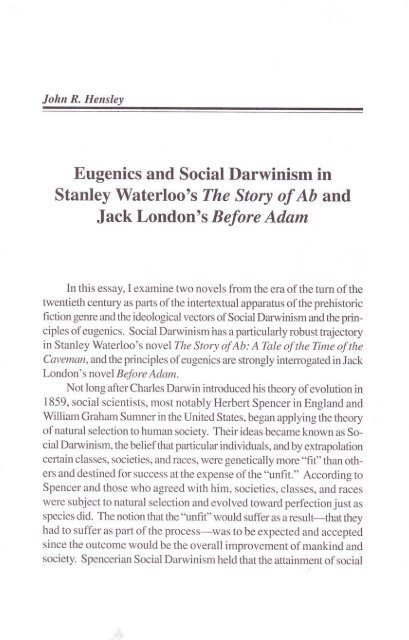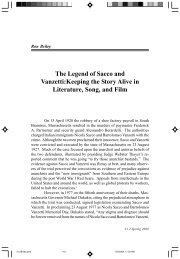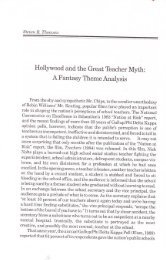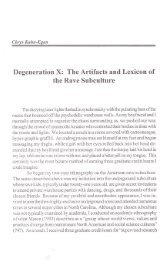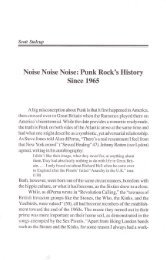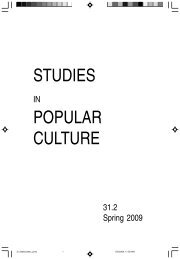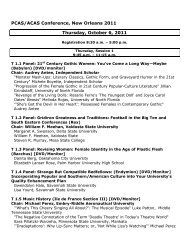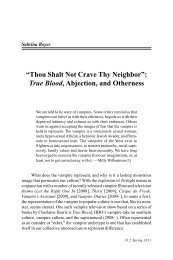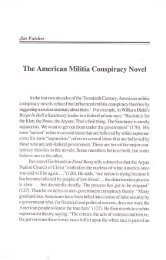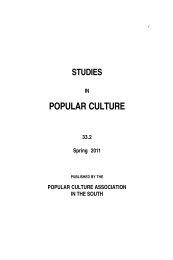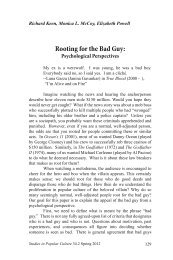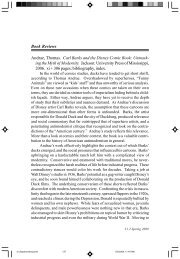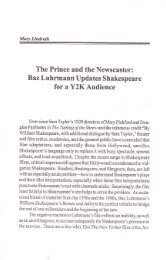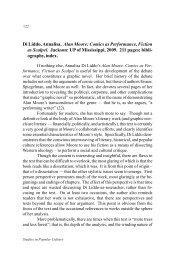Eugenics and Social Darwinism in - Popular/American Culture ...
Eugenics and Social Darwinism in - Popular/American Culture ...
Eugenics and Social Darwinism in - Popular/American Culture ...
Create successful ePaper yourself
Turn your PDF publications into a flip-book with our unique Google optimized e-Paper software.
John R. Hensley<strong>Eugenics</strong> <strong>and</strong> <strong>Social</strong> <strong>Darw<strong>in</strong>ism</strong> <strong>in</strong>Stanley Waterloo's The Story of Ab <strong>and</strong>Jack London's Before AdamIn this essay, I exam<strong>in</strong>e two novels from the era of the turn of thetwentieth century as parts of the <strong>in</strong>tertextual apparatus of the prehistoricfiction genre <strong>and</strong>the ideological vectors of <strong>Social</strong><strong>Darw<strong>in</strong>ism</strong> <strong>and</strong>thepr<strong>in</strong>ciplesof eugenic s. <strong>Social</strong> <strong>Darw<strong>in</strong>ism</strong> has a particularly robust traj ectory<strong>in</strong> Stanley Waterloo's novel The Story of Ab: ATale of the Time of theCaveman, <strong>and</strong> the pr<strong>in</strong>ciples of eugenics are strongly <strong>in</strong>terrogated <strong>in</strong> JackLondon's novel Before Adam.Not long after Charles Darw<strong>in</strong> <strong>in</strong>troduced his theory of evolution <strong>in</strong>1859, social scientists, most notably Herbert Spencer <strong>in</strong> Engl<strong>and</strong> <strong>and</strong>William Graham Sumner<strong>in</strong>theUnited States, began apply<strong>in</strong>g thetheoryof natural selection to human society. Their ideas became known as <strong>Social</strong><strong>Darw<strong>in</strong>ism</strong>, the belief that particular <strong>in</strong>dividuals, <strong>and</strong> by extrapolationcerta<strong>in</strong> classes, societies, <strong>and</strong> races, were genetically more "fit" than others<strong>and</strong> dest<strong>in</strong>ed for success at the expense of the "unfit." Accord<strong>in</strong>g toSpencer <strong>and</strong> those who agreed with him, societies, classes, <strong>and</strong> raceswere subject to natural selection <strong>and</strong> evolved toward perfection just asspecies did. The notion that the "unfit" would suffer as a result-that theyhad to suffer as part of the process-was to be expected <strong>and</strong> accepteds<strong>in</strong>ce the outcome would be the overall improvement of mank<strong>in</strong>d <strong>and</strong>society. Spencerian <strong>Social</strong> <strong>Darw<strong>in</strong>ism</strong> held that the atta<strong>in</strong>ment of social
arnllnJ t,lndod ut salpnts-elud eql ueet\leq uorsrlrp fuuqs ou su,lr eJeq] luql uorluoluoc srq uod-dns ol roqlnu eql ,(q pesn sr qy ',(pruuy luuosred e3.ru1u;o qcrer4ud eqtpue pueq srqJo repuel eql seuoceq puu 'aqu1 Surpulur uB tsuruSu olnuq1ee:3e ur eldoed srq speel te8q qloot-raqus Surprcre m{equ eqt sdleq eqteplo smor8 qV sV 'eqrrl Sur.roqq8reu e ruo4 ueruo,l ?uno,( eqt sunocpue 'uuru eJlesIUq erro;d ol eqrJ] oql qll,4\ lunq qlolullleru u uI seledtctl-.red .(oq Ilerus B ,(1uo ueqm sorocoulqJ,(qeq e sellrtuc pue 1rd e s81p qVlsruo8elord eql A\oq silel IeAou s,oolJolely\'fuo1s ,,e8e;o 8uturoc,, u,(1uud'uaaa^D) aqt {o aru1 aql to apJ V :qV {o {,ro1g aql le^ou rlro}slq-erd rulndod L68I s.oolJepl6 ,(ep4g ut e;aqrvrr(rele eJB ,tuouadns cruol-neJ puu rusrur^\req Iercos Jo stueuodord eq1 ,(q quog tnd suepr eq1'srrul^eulpuucs puB'qsq8ug 'suuuueg o] roueJur uoqsenb lnoqlrl\ erezr 'uoqeJueur8rd uqsu,^AOJqJO {Culq qtr.r,r. eldoed 01,,.rouedns,, ,(lprcur Sureq ellq1Yt's1ee:9puu 'suur1ull 's^els 's,ue1]Brl] pleq osls solJoaql eseqJ ',(peqt1 IEcIlll-od puu'serSolouqcel prcgeueq lsoru'rusrlultduc 1e>1mur-ee4 Jo,,uonuol-ur,, Jrotfl ,(q pecueprrre se ,,Iouedns,, ,t11ucrleue8 e.lem seldoed ,ruBlrueDpue 'crprog'uoxeg-o18uv eqleqt pepuetuoc ,(eq1 'ut8uo oluotneJJo,,secuJ,,Jo,Quouadns aq1;o,ftoeq eq] SuDoruord ue8eq sse8rng '1$, uqotpue Jaqra-I srcueJC slsrluercs 1ecr11od puB 'sruepv Jelxefl uoqJeH puegorcueg eS.roog srruuotsq 'uollv ruullr,1\ ]srcrssulc 'xou) ueqoU prSolorq'seuoeqJ IBrcos ,{-ruuor1n1o.te Jlor{l uo Sutpunodxe pue Sutdolerrep eremreuruns ruBqurD ruullllly\. puu"Iecueds ueqreH orurl erues"rlrrrY*rn,Jo ..eouercs,, eqlJo ]ueudolerrep eq] pue slsrur.&ue6l IBTJoSJo suorlu;eue8luenbesqns pecuengut s?epr esoq.lA uosted pquenuu pup snoro8r,r e surlr'slurod ,(ueru uo s,:ecued5 qlr,l peu8u ,(qdosolrqd esoqr* ':euurns JeuunsuBqeJD rreqlr 11JosseJord e1u1 servr lsrurl(Jeq Ieloos uno:Seuroq lueu-nuord tsoru eql 'uouetuv uI 'acJoruruoc puu ,(4snpur ur e8qserd pelnbcupuu seunuoJ JraqJ ,,epetu,, puq orl,l\ slsrunuoddo qclJ,(1meu puu 'qllue,lpue re,uod pelrJequr puq oql\ ',tcurcolsrru eq] qtoq Jo {colq eArJuAJes-uor p Jo pasuduroc 3ur,r,ro11o3 e8ml u peq recuedg tpuenbesuo3 ',(1uo-uedns cr1eue33o sJa{JBru eJeA\ q}1uel*Jo uouelntunocu eql puu eSqse-rd,{alsueg ;7
<strong>Eugenics</strong> <strong>and</strong> <strong>Social</strong> <strong>Darw<strong>in</strong>ism</strong> 25olithic <strong>and</strong>Neolithic periods-thathumans leamed to make f<strong>in</strong>e, polishedtools <strong>and</strong> weapons gradually <strong>and</strong> naturally, as Ab does <strong>in</strong> the book. Dur<strong>in</strong>ghis life, Ab also <strong>in</strong>vents <strong>and</strong> perfects the bow <strong>and</strong> arrow, <strong>and</strong> is the firstto domesticate wolves.In the beg<strong>in</strong>n<strong>in</strong>g of Ab the Caveman, Waterloo goes to great pa<strong>in</strong>sto <strong>in</strong>form readers that the tale takes place near the banks of a stream laterto be known as the Thames, which <strong>in</strong> "the Age of Stone" emptied not <strong>in</strong>tothe English Channel, which did not exist at the time ow<strong>in</strong>g to lower sealevels, but was <strong>in</strong>stead a "part of a great affluent of the Rh<strong>in</strong>e, the Germanriver famous still, but then with a size <strong>and</strong> sweep worth talk<strong>in</strong>g of ' (4).Waterloo writes: "Then the Thames <strong>and</strong> the Elbe <strong>and</strong> the Wesser, <strong>in</strong>towhich tumbled a thous<strong>and</strong> smaller streams, all went to feed what is nowthe Rh<strong>in</strong>e, <strong>and</strong> that then tremendous river held its course through denseforests <strong>and</strong> deep gorges until it reached broad pla<strong>in</strong>s, where the NorthSea is today, <strong>and</strong> blended f<strong>in</strong>ally with the Northern Ocean" (4). Althoughon its face it may appear that Waterloo took such pa<strong>in</strong>s to situate his story<strong>in</strong> "correct" prehistoric geographical terms forpurely "scientific" reasons,he does so <strong>in</strong> a way that also makes it clear that the narrative takes placewith<strong>in</strong> a greater "Teutonis" lenlm-1he locus of the evolution of the "superior"Teutonic "races."One of the tenets of the theory of the superiority of "races" of Teutonicorig<strong>in</strong> was that these "races" were responsible for most technologicaladvancements throughout history. InThe Story of Ab. Waterloo extendsthis to <strong>in</strong>clude prehistory. In an <strong>in</strong>troduction to the novel, he writes:After an at least long-cont<strong>in</strong>ued study of the exist<strong>in</strong>g evidence<strong>and</strong> <strong>in</strong>formation relat<strong>in</strong>g to the Stone Ages, the conviction grewupon [Waterloo] that the mysterious gap supposed by scientificteachers to divide Paleolithic from Neolithic man never existed.No convulsion ofnature, no new race ofhuman be<strong>in</strong>gs is neededto expla<strong>in</strong> the difference between the relics of paleolithic <strong>and</strong>Neolithic strugglers. Growth, experiment, adaptation, discovery,<strong>in</strong>evitable <strong>in</strong> man, sufficiently account for all the relatively swiftchanges from one form of primitive life to another more advanced,from the time of chipped to that of polished implements. Man has25.1 October 2002
atnunJ rDlndod ul salpnlsur eJeA\ ,(ew JI ue^e puDI ur ,^Aou Jou eJe.rn 'seSuuqc grl\s qcns ,(q tqSnormsuJecuoc lercos luulltuocuoo eq] pue ',(rnluec aqlJo uJn1 oqlJo uJe eqlur pecueuedxe se8uuqc Urly\s eql lBql ecueJnsspeJ eql w \ ,ftoeql e^rlcrJs.oolrete A ur perldtul '1sud rurp eq] ut ,,euoJs peqslodgo tuq] ot ouotspeddrqc;o orurJ oqJ,, ruo:y e8uuqr Ur, s er[Jo uoqeueldxe oql uuq] suorl-ecqdut:epll\ puq tlruuurnq ul luoJequ (rrr.) ,,f:e,rocsrp 'uorlqdupu lueur-uedxo'qJ,tor8,,;o suuet ut elqucrldxe su,l\ crqlrloeN er11 pue crq]lloeledeq] ueo^\teq du8 elqucqdxeu er11]pq] uorluynlsod srq'eruq equo qcJuesercgrluercs prm seuoeql peldeccu eql ruo+ uorlenep e13urs s.oolJele I'uorJprcossp srql q8norql ecuepeJcJo ]eqc-uc eql uea,t?,(qereql em,,t1uouedns,, JruolneJ pue rusrurl\Jeq Ierco S Joesoqt tprctdun spunodxe eq seuoeqt eql'seuoeqt wueluoqtne,(1m1ndod4eqt ot slueddu oolretul11'srurel pcrSoloeqc.re pue pcrSolodorqlueoeepdpeldecce ,(11ureue8 puu ,fueuorlnlole uururlv\Jeq ,(prcrldxe ur uorl-cg srq go fllplu^,,cgpuercs,, eql 8ursse4s,(g'a8ueqc pcrSolouqcot Ur^\s;o ,&oeqt srqyo uoqdeoxe euo eq] qlll\ '(l) ,,qc;uasoJ crJrlueros pue serJ-oeqt petdecou,, ul pesuq sr Ielou sH luql elurce.tddu ol sJepueJ slued\ ool-retui& '(a.) ,.seurq cuolsqe.rd;o ,fto1sq eyl er4 olut slueuuuoc oA\1Jo sre-r.lcJues ]selq? erlJo etuos ,(q pelsrssu ,(lulproc ueeq seq Joqlru eql {Jo1(sIqJ uI,, luqt sJepeeJ seJnssu oolJele 11 '{ooq eq}Jo Suruur8eq eq} u1,, r(Juouedns,, cruoJneJ ur Jolloq aql.re1s1oq ol ldueltp ue sp.^A srqt A\oq pue 'seFoeqt pup e8pelmou4 ogrluercssnoeuerodureluoc ol {JoA\ elr}uur8eur srq ser} fprcldxe oolJelul6 1(oqsr ,(usse srql;o lurod eql ol eJoIAI 'Surlse;elur eq plnol\ ,,'s3.ooJd,, elrlcgslr puu ',(Joeql sql o] anr8 ot sJepEeJ slcadxe oolJelu I ecuopeJc qcnuA\oq uo uouepcedg 'poped eqtJo sotrupuunb pcrSoloeuqcJu Surxeld.red]sou eqlJo ouo'r(€zvr e,LrleurSerur uu ur'ea.1os ol q8noue eru,{lerrquercpuu ,(lrnue8ut uerunq luqlJerleq pol\olp s.oolJelelv\;o tlercryedns 'errr1-u.t1snllr sl puu'peepur.,e8uuqc gr,ls,, sr sr{,L 'oupeJII s.ueru euogio uedsuoqs eqt urqtrl\ eculd 1oo1 'crqryoeN eril ot crql[oelud eq] tuo4 e8uuqcor.DJo $lJutuller.l 'sluorueldul euols Surqsqod;o uorlulouur sH prre 1r\ormpue^\oqeqtJo uoDue^ur s.qv reDg ,(lqe.usuoulep eq] 'qyrfo [.totg aqJul(ra,-,t)'uoqnlo,re ;o sec;o.; 3urue1-seq-Je^ou '3ur1ser-re,reu eql repun 'Suruut8eq eql ruoJ-I .ueeq,(eysueg 97
<strong>Eugenics</strong> <strong>and</strong> <strong>Social</strong> <strong>Darw<strong>in</strong>ism</strong> 27scope. The Story of Ab cantherefore be read as an attemptto confirmthat these k<strong>in</strong>ds of th<strong>in</strong>gs had happened before as the result of technologicaladvances made by the superior Teutonic "races," which races hadtime <strong>and</strong> aga<strong>in</strong> discovered ways to solve these problems through isolation,dom<strong>in</strong>ation, violence, <strong>and</strong> their genetically "superior" morals <strong>and</strong> <strong>in</strong>tellect.The climax of the The Story of Ab rs a celebration of the superiorityof the genetically fitterAb <strong>and</strong>his people,labeledby Waterloo the "WesternCave Men," as demonstrated by the successful defense of their hometerritory from <strong>in</strong>vasion by the "Eastern Cave Men." Ab <strong>and</strong> the WesternCave Men have moved <strong>in</strong>to "The Fire Country," aplace discovered byAb <strong>and</strong> subsequently colonized by him, his family, <strong>and</strong> their kith <strong>and</strong> k<strong>in</strong>.The Fire Country is a natural fortress-a valley almost completely encircledby a natural wall of flame, created by natural gas leak<strong>in</strong>g from a greatcrack <strong>in</strong> the ground ignited by lightn<strong>in</strong>g, <strong>and</strong> by sheer rock outcropp<strong>in</strong>gs.The Fire Country is well stocked with fresh water <strong>and</strong> plenty of the otherresources needed by the Western Cave Men.In the chapter "The Battle of the Barriers," the more numerous EasternCave Men, led by their swarthy leader "Boarface," contest the possessionof this most felicitous place by Ab <strong>and</strong> the Western Cave Men(264-286). The outcome of the battle is <strong>in</strong> doubt more than once, but Ab<strong>and</strong> his Western Cave Men carry the day through superior tactics <strong>and</strong>technology by us<strong>in</strong>g the natural barriers <strong>in</strong> the most efficient ways, <strong>and</strong>because they possess more <strong>and</strong> know how to use more <strong>and</strong> deadlierweapons than their enemy. After the battle, the Western Cave Men alsodemonstrate their "moral superiority" by adopt<strong>in</strong>g the prisoners they havetaken <strong>in</strong>stead of kill<strong>in</strong>g them. Waterloo gives us this "<strong>in</strong>sight" <strong>in</strong>to thereason<strong>in</strong>g of both factions on this forced assimilation:There was a council that night between Ab <strong>and</strong> his friends <strong>and</strong>,the easiest way of dispos<strong>in</strong>g of the prisoners <strong>in</strong> the cave, it wasproposed to block the entrance <strong>and</strong> allow the miserable losers <strong>in</strong>battle to there starve at their leisure. But the thoughtful Old Mok[Ab's mentor] took Ab aside <strong>and</strong> said:25.1 October 2002
atnlln) tDltldod ut satpnlsruo4 03 ot stus,(lcutpo IerntBU tuer8Jo eruJ eql ur ssorSord (eqg 'serurlJuolsq ol Jrltqoeled oql tuo4 r(tpnd prcBJ ureloJ1serelelc puu lseJmJ puelse8uorls eqt'toopq8l.I puu qVJo sluepuecsop eql '(062) ..socroJ o,^a]eqlJo I{ceo Jog poo8 8urpue1q,, e-..sJeqJotu,, uourol\ uerfty pue ..s.lJes,,ueur uu,{ry eq} SuDIur.u 's;epea.ur ue,fuy luu]rlltuJo suorsJncur eql ue^elsute8e punor8 Jror4l ploq plnod\ oql\ eJ€J ueedorng uJeJSeA\ e Jo stue-rudpuer8 ,Seet3,trerr,, eql Sururoceq'e8e p1o ol polrlJns eleq looJlqSr-Ipuu qV'lueqdurnr4lnq peJellpfl,,'ecuJ 3ur1su1e oJnsur os puu s:emodrelrturs Jo uerplqo leer8 rog e;ec puu peerq '8uuds;3ro.rreql tceto:d plnoc'otun eqlJo lsaJenel, pue ]seJrpJ oql eqs 'lse8uorls oql 'eq iuuuro,u, elrl-rurud se,r,r gg4r-BJ pue tueppd lppu lueru ea.qrurud su.,t,r 8uols,, :selu.l.r eH'e^g pue tuepv orpJoNJo puH u se 1oo;1q8r1 eturu srq pue qV stuese:doolrelul(\'eArluuuu eqtJo pue eqt tu sreurBg erilJo opteg eql reuv'sJeDoq:ouadns eJoJoJoql pue JellrJ ,(lqu4suoruep Jreql JoJ {JoA\ o1 ee:8e puu'seqnue; Jraql puu sellesueql roy sr(un ,sroJenbuoJ eql ldope 's;o;enb-uoc JreqlJo ,(1Foqlne eql ]dmce ..sJesol elquJesrur,, eqt;r ,(1uo 1nq-crl reue snounuuuS?u eq ot proJJe upc uel "tro1I eAeJ uretsod\ eq] puu qV'ur.^A IIrA\ ]se A OrDJo ecueulv peuo4seq-,(1errueu eql w pecuocsue souo,.Jouedns,, eql lnq'e1u;edsep puu IueJ sr lsug eq] uro4 sJopunut ,(quurtrsJo uorse^urJo lu3rqt eIlL 'usFeluv ur peqsrTqulse,(pue"r1u esoql ol pesod..uorsB^ur,, Jrew lBeJql perrrec"red eql puu lseg eq] luo4 sluerSrurufl A\eu eq]rllrly\ perueouoJ suorJsenb ,fte:odureluoc '(e,l Bu11glry-qsll\ ? ur sJeltsuuprm 'sesse;ppu,{lerrrleur8uur oo1.re1u16'r(e,l slql ur elrlurreu srq Surpue u1(997) 'eldoed fe11ea. eqr;o eueceq'roJ lues eJe^\ oq^\ 'ueJplrqr pue se^r^\ rreql qlt,^A .puu peJ puBtno etuuc puu ,firroq1ne s,qy peldeccu ,(eq1 .poo8 su,u fe11e,,r.eqJ 'uousenb 1en; puu pooJ eql Jo eprslno s,^[erl llroxeu oupeq ,(eqt puu roJ el,uoc peq ,(eql teq.r,r ererrr se8elue^pe Jeqlo slrpue ,(e11ea. aqt Jo r{trruB/( eq; '3uo1 etutrseq tou plp ,(eq1 .drqs-uorueduroc luerpeqo Jo rneep Jo onrluuJelle eql ue,rr8 eJe,4a ueurpeuosudtur ',(r8unq oqt pu€ sqt.lo IlB.lo uos?eJ eql^\esOO O.:X-uorts sn e{Eru puu ,{e1s uec ,(eq1 'peluuzrr,(eqt eceld oW sl;lqJ'fes no,{ se op IIr^\ ,(eq1 lsn ro; yol\ pue e^r[ ueql lel lou ,(q16,,,{eysueg 97
<strong>Eugenics</strong> <strong>and</strong> <strong>Social</strong> <strong>Darw<strong>in</strong>ism</strong> 29wield<strong>in</strong>g "the smoothed stone weapons" of Ab's conceptionto "thebronzeaxes" as they diverge "<strong>in</strong> many branches of contentious defenders <strong>and</strong><strong>in</strong>vaders, to become Iberian <strong>and</strong> Gaul <strong>and</strong> Celt <strong>and</strong> Saxon, to flght familyaga<strong>in</strong>st family, <strong>and</strong> to comm<strong>in</strong>gle aga<strong>in</strong> <strong>in</strong> these later times" (290).In these later times, the "good blue blood" of Ab <strong>and</strong> Lightfoot rema<strong>in</strong>spotent, for among their descendents are numbered these <strong>in</strong>dividuals:[. . .] a woman, cultured, very beautiful <strong>and</strong> wise <strong>in</strong> woman's way<strong>and</strong> among the fairest <strong>and</strong> the best of all the earth can produce[. . .] a rugged man, gentle as resolute <strong>and</strong> noble [who] becamethe enshr<strong>in</strong>ed hero of a vast republic, when he struck from slavelimbs the shackles of four million people [. . .] an old man vigorous<strong>in</strong> his octogenarianism, a power, though out of power, afigure to be a monument <strong>in</strong> personal history, a great man[. . . ] one who has bound the nations together <strong>in</strong> sympathy forLes Miserables of the earth [. . .] a bald headed giant <strong>in</strong> cavalryboots, one who has dictated arbitrarily, as premier, the policy ofan empire he has largely made. (291)Ab <strong>and</strong> Lightfoot's success-their survival <strong>in</strong> a hostile environment-thusleads directly, if remotely, to thebirth <strong>and</strong> successes of the "Ideal'Woman"<strong>and</strong> "Super Men" such as, <strong>in</strong> a disturb<strong>in</strong>gly oblique way, Abraham L<strong>in</strong>coln<strong>and</strong> Victor Hugo, <strong>and</strong>, not so tangentially, Otto Von Bismarck. Ab <strong>and</strong>Lightfoot were, <strong>in</strong> eugenic tems, a genetically ideal couple deserv<strong>in</strong>g ofprivileged reproductive status.B y the early years of the twentieth century the ma<strong>in</strong> po<strong>in</strong>t of Darw<strong>in</strong>'stheory of evolution had been utterly altered by the <strong>in</strong>fluences of <strong>Social</strong><strong>Darw<strong>in</strong>ism</strong>, race theorists, <strong>and</strong> an <strong>in</strong>complete underst<strong>and</strong><strong>in</strong>g of the pr<strong>in</strong>ciplesof genetics from its orig<strong>in</strong>al focus on the orig<strong>in</strong> of species to thepseudo-science of "eugenics," a tetm co<strong>in</strong>ed by Charles Darw<strong>in</strong>'s cous<strong>in</strong>Francis Galton <strong>in</strong> 1883. Galton was a mathematician <strong>and</strong> scientist whowas greatly impressed <strong>and</strong> <strong>in</strong>fluenced by his older cous<strong>in</strong>'s theoreticalwork <strong>and</strong> determ<strong>in</strong>ed to exp<strong>and</strong> upon it. His contribution, which he called"eugenics" from a Greek root mean<strong>in</strong>g "well bom," was the conception ofa science that would improve the human species giv<strong>in</strong>g, <strong>in</strong> his words quoted<strong>in</strong> Pat Shipman's bookThe Evolution of Racism: Human Dffirences25-l October 2002
arntln) tDlndod ul salpntsIuur8uo eqt Suue8e-r8es;o lsoc eq]teqt percturlselelqdrued eq1go roqtnusnour,(uouu eq]'sel^e) 'I Ieluu(l rrBFotsq q Surp.roccy 'eruq 1eq1o1dn000'000'Z$ ]noqe {ro1 ,^deNJo etuts eqt }soc peq sese{nl pur8uo eq}JoSurpee:q pelcer.lrun Surzvrollu;o slcaJJe eqt ]uq] petBrunse tBw telqduudu peqsrlqnd,(lercog scrue8nE uucueruv eqt':ea,t teqt q '9I6I ur potrcSureq 1us sulr,(prus so{n[ eql 'srsuq'plueuruonluo uu ]ou'cqeue8 e peqsllr prcos ,(ueru 1er11-,QerJos uecuetuv q selqunsepun lnoqu suorcrdsnstsJol( aq] peJJoJure-r,(FueJ selnf arl]Jo r(pn1s s,e1ep8nq '>Foa meNeplsdn ur perrq oq.,t,r e1dnoc,,1guq, r(lpcqeueS r(pSnoroql euo qlmr 3u4re1s'suotluJeue8 ue,res uur{l eJou:o; edlrls ,(rerre;o sp-ren81cu1q puu 'sre8-8eq'spururFc'seln1r1sord;o r(11soru'elup8nq o1 Surprocce'pesudruocSureq Jo pnord eq o] olpll,fte,t peq,(lpreg se>lnf eq1- 'LLg1 ur,(pruugselnf oqlJo ,(pn1s srq peqslqnd oqm 'e1up8nc prer{cruJo Iro^\ eqt ,tq,,]ueJeddu,, epeur sp,lA 'peeJq ol pel\ofle eq ]ou plnoqs spnprlrpu ..eAr]JeJ-ep,, ,(1pcqeue81eql'uloc scrue8ne eqlJo eprs Jeqlo aql'ucueruv uI'se8uu;uur;raql Surle.rqelm prre Suuosuods ueql puu'tlraru ctteue8 puorldecxe qtrm esoql 3q,!puep1 'en1ua, ,ftelrpereq ro; ecel-ndod Surpee.rq eql Surzruqrucs ,(q pe,ryo,rul oruooeq plnoqs luaruuterro8t{splrg eqt teqt pesodord puu qcoJs Surpee-rq eqtJo &rrcnb aqt potceuerssoJJns uutunq ur sooueJeJJrp oW luql peurclurutu uolpg '(f t t ) ..suoDBJe-ue8 e,rqncesuoc IuJeAes Supnp se8erueur snorcrpnir(q ueuJo eca pegt8,(1q8rq,, u pee:q,(lenrpelas ol sul\ serceds uerunq eql erro.rdrul ol op o13qq1lectSol lsoru eql luql'selou uuurdrqg lud sB '.pepnlcuoc ueqt eH 'sesougo edeqs pue ezrs eqt puu lo1oc er(e'lq8req se,ftulrpereq se eJoA\ ecue8-rlletur pue lelcuJeqc 'flnquerc se s8urq] qcns luql eJoJeJerD prru ,slenprl-rpur :ouedns pue e,rqcnpo;d qcns ecnpord o1 pesodsrp,(leluuorgodord-srp aJaA\ serlruruJ uruuoc luql epnlJuoJ ol tulq pe1 poued ree,{-pe-rpunq-o1!u e JeAo 'uau ,(relqnu 'gsquelcs 's1eod Surpnlcur ,slea.erqce lueururordJo saIpUS s.uolleD ',{luouedns crleue8go sJolecrpur ano{ouu.tdercntslunpr^rpur ,(q eSrlserd IErJos Jo lueluurcilB eql puu qll?3^\Jo uorlBlnur-ncce eqlur11uepr eqlpelcela; teuurng puu recuedg e>lqun.uo]pC'(t t t) ..elqulrns ssel oq]re^o,(ppeeds Suqrerrerd;o erueqcregeqe poolqJo suIuIS Jo seouJ alqelrns aJoru erp,, 'acuatcg {o asnqv puo asn aqt pun,{elsueg 69
<strong>Eugenics</strong> <strong>and</strong> <strong>Social</strong> <strong>Darw<strong>in</strong>ism</strong> 31Jukeses from the rest of society for life, <strong>and</strong> thereby obviat<strong>in</strong>g the problemswrought by their genetically flawed offspr<strong>in</strong>g, would have been about$25,000, <strong>and</strong> the cost of steriliz<strong>in</strong>gthe orig<strong>in</strong>al Jukeses would have beena barga<strong>in</strong> at $150 (91).As was <strong>Social</strong> <strong>Darw<strong>in</strong>ism</strong>, eugenics was rooted <strong>in</strong> n<strong>in</strong>eteenth-centuryconfusionof national identities withrace <strong>and</strong>nourishedby the uneasecaused by the perplex<strong>in</strong>g collection of social, political, economic, <strong>and</strong>cultural changes that occurred <strong>in</strong> the era of the turn of the twentieth century.<strong>Eugenics</strong> enjoyed a reputation as a potent, objective science thatpo<strong>in</strong>ted the way to counter<strong>in</strong>g the perceived threats posedby these changes.The man mostcredited withbr<strong>in</strong>g<strong>in</strong>g <strong>Eugenics</strong> to AmericafromBrita<strong>in</strong>,where it had ga<strong>in</strong>ed a stronghold under the auspices of Galton <strong>and</strong> hisprotdgd Karl Pearson, was the Harvard-tra<strong>in</strong>ed biologist Charles Davenport.Davenport did much to develop the "science" of eugenics. Heworked to capture <strong>and</strong> ma<strong>in</strong>ta<strong>in</strong> hereditary <strong>in</strong>formation on <strong>in</strong>dividuals, lobbyfor eugenics-based legislation, <strong>and</strong> popularize eugenics through the auspicesof the <strong>Eugenics</strong> Record Office, which was f<strong>in</strong>anced <strong>in</strong> large part bythe extremely wealthy Mrs. E. H. Harriman. Davenport was not alone,however. For example, at the same time Davenport was active, <strong>and</strong> withhis collaboration, the <strong>American</strong> Breeders Association (ABA) devoteditself to <strong>in</strong>vestigat<strong>in</strong>g eugenics issues. The ABA formed a committee thatfocused on the presumed hereditary differences between human races<strong>and</strong> actively popularized the themes of selective breed<strong>in</strong>g of superior stock,the biological threat of "<strong>in</strong>ferior types," <strong>and</strong> the need for record<strong>in</strong>g <strong>and</strong>connoll<strong>in</strong>g human heredity. One of the strongest supporters, <strong>and</strong> f<strong>in</strong>ancialbackers, of the eugenics movement was cereal magnate J. H. Kellogg,who founded the Race Betterment Foundation <strong>in</strong> Battle Creek, Michigan,<strong>in</strong> 1906.Also <strong>in</strong> 1906, the same year Kellogg created the Race BettermentFoundation, <strong>American</strong> novelist <strong>and</strong> short story writerJack London enteredthe eugenics discourse when he began the serialized publication ofhis novel Before Adam.London, who would author over fifty books offiction <strong>and</strong> non-fiction <strong>in</strong> his short life, is known today for his romantic25.1 October 2002
atruln) rDlttdod ul salpnts-ez\rc8to Iprcos prm e8en8uel rft4uoturprue r(po ssessodpue tSolouqcelou o^uq'seeJ] ur errq r(eq; ']eeJ JroqlJo selos eql Jo'srupd ,secu; rreql uoJIut{ ou eABq lnq '1ea.ou eql ur so3eJ ot\t Jeqlo arp ueqt e:ou sedu alqruoseJe1doe4 ee{ or{J ,,'e1doe4 ee{,, eqlsruopv an{ag ur..ocuJ,, }se,l\oleq; 'e1e:edoo, o] olqu puu pezue8ro ile1vr oJu pue 'e8un8uul peJuelpu,(1e,tr1e1e: u oluq'A\oru pue A\oq oql esn'se:g aluru'sur1s mely\'selecur eArT,(eqa 'o1|1:eqlo aql ueq] qleal Jelluurs e^eq pue 'surre -regoqs e^eq'pedools ssol eJu 'speeqJellerus erreq r(eqa 'seceJ olUJeqlo er1 su rfuruq selou eJ? ,(eqa 'suerunq ueporu e{[ lsoru ]JB pue {ool ,(eql l,,sece;,, eeJqleqtJo ..po3rrurrpu,, ,(1p.lnllnc pup ,(1pcls,{qd lsou aql em eldoe4 oJId etLL..'e1doe4 oJrd,, eq] eru,(qcru:erq IprceJ eqtJo dol eril ly 'ruopy an{agur seJpJ lourlsrp eeJql oJu eJeq.I ,,'eceJ,, ]uuururop a;oJeJeq] puu louedns,(1me1c e;o reqrueur e lou sr ept s.uopuol ut,,oJor{,, oql }Bql sr s.oolJe}u Apuu looq s.uopuo'I uoeAueq ooueJeJJrp puno;ord ]so{u orIJ'tusrcuJ cruo8ne ;o,,se1dnupd,, mlndoduaqt,(q eqlJo r(ueru seluSorrelur oArJBJreu s.uopuo-I teloerol4l 'uol+Vur eJer.l1!\etuos ,{:o}s srq se}Bcol uopuol ielduuxe ro; ,,,,(luouedns,, cruol-neJ uo srsuqdua ou sr oJeqJ 's(u.r,r ,(ueu ut qy{o {-to1g aqlelrTun srwopy antag tezre,loll 'qv{o ,Cto1g aqlsoop sB .,,sacuJ,, pue.serlercos'sesseyc 'spnprlrpurJo ,,]sellg oqlJo IeArAJns,, eqlJo ldecuoc uururA\JBCprcos eql o] sereqpu osle ruopy a.to{ag 'e1r.;t srq ur sr oolretely\ uuql lsedeqlgo 1md 1uq^\ tnoqu cgrceds ssel qcntu sr uopuol q8noqtp ,1sed ru; eqlur eceld saletruDpv an{ag 'qv{o tL,tolg aqla{r-I .{ro1!\ slq Surzuer8uldJo uopuo-I pesnccu 'treJ ul 'oo1:e1ep1 '16gl ul peqsrlqnd ,qy{o {.to1gaqJS.oolre1e16,{e1ue1g qtr^\ uotutuoc ur qcnu sequopy a"to{ag'ulq fq pez,(1uuu puu rolsecue sqgo,,se,(e [uue.tp,, eql q8noJq] ueos su trerunr{ elrnblou Surequgo oJII orl}Josuorsse;drur srq SuqredrurJo eturuel1p aqt WI^\ se133n4s "rolurreu tuepotueqt 'Iooq eqt tnoq8noJr1J 'uorluzruu8ro Iercos qJnru;o .e8en8uel ,elylnoqlrll\ ..eJeJ,, uJo Jeqrueru e tolsecue eumolsreld-pnu s.JoJrJly\ Iuuorl-JU er{tJo selJorueu uruerp or{}Jo SurTIe}eJ aql su el4urreu sqt pelueserduopuoT :sele,t esoq] tuo4 luoreJJrp qrnu stuopy ato{ag .7uog aqqilpue pryful, aqt {o 11o3 Surpnlcur 'yulr.a.rns -ro; se188ruls ptueruela Jo selul,{elsueg 7g
<strong>Eugenics</strong> <strong>and</strong> <strong>Social</strong> <strong>Darw<strong>in</strong>ism</strong> 33tion. The third "race" <strong>in</strong>Before Adamtsthe "Folk." The Folk look lesslike modern humans than the Fire People do <strong>and</strong> less like apes than theTree People do. Like the Tree people, they use a basic form of voc alizedcommunication, although they do have a larger vocabulary than the TreePeople. Unlike the Tiee People, the Folk have some technology-sticks<strong>and</strong> stones used for weapons, gourds used to carry water. Like the FirePeople, most of the Folk live <strong>in</strong> caves, but they lack the Fire People'ssocial organization <strong>and</strong> are therefore less able to cooperate <strong>and</strong> act <strong>in</strong>coord<strong>in</strong>ated activities such as hunt<strong>in</strong>g <strong>and</strong> warfare.These "racial" differences seem to be profound, particularly the differencesthat separate the Fire People from the other two. However,London seems to suggest that even these differences may not be so greatas they seem, at least <strong>in</strong> "genetic" terms. "Certa<strong>in</strong>ly," the modern narratorasserts <strong>in</strong> the novel, "all three k<strong>in</strong>ds were related, <strong>and</strong> not so remotely atthat" ( 163). What London appea.rs to be argu<strong>in</strong>g is that the "races" aredifferentiatedby someth<strong>in</strong>g thatis not so much genetically "<strong>in</strong>heritable" asitis culturally determ<strong>in</strong>ed, <strong>and</strong>this <strong>in</strong>quiry is cenffal to thema<strong>in</strong>character'slife as <strong>in</strong>terpreted by the modern narrator.The modem narratorcalls the prehistoric protagonist<strong>in</strong>Before Adamby the name of "Big-Tooth" s<strong>in</strong>ce he has unusually large can<strong>in</strong>es even fora member of his "race." Big-Tooth is a member of the Folk. The story ofBigfoot's com<strong>in</strong>g of age rnBefore Adarz, unlike Ab's <strong>in</strong> The Tale of Ab,is one of cont<strong>in</strong>ued somow <strong>and</strong> misfortune atthe h<strong>and</strong>s of cruel <strong>and</strong> mercilessmembers of his own "race" <strong>and</strong> of the other two. Big-Tooth is atfirst persecuted by his stepfather, the "Chatterer," <strong>and</strong> thereafter terorizedby the atavistic brutal bully of the Folk, "Red-Eye, who really shouldabide with the Tree People, accord<strong>in</strong>g to the modern narrator, <strong>and</strong> who <strong>in</strong>the end does. Big Tooth also must occasionally dodge the arrows of FirePeople hunt<strong>in</strong>g parties, who apparently have a taste for the Folk. UnlikeAb <strong>in</strong>Waterloo's novel, Big-Tooth accomplishes no greatth<strong>in</strong>gs <strong>in</strong>his life.Big-Tooth's one attempt to contribute to what the modern narrator mightconsider progress is unsuccessful; when Big-Tooth br<strong>in</strong>gs home a wolfcub to play with, his gluttonous friend <strong>and</strong> ally "Lop-Ear" kills <strong>and</strong> eats it25.1 October 2002
arnlln) tDlndod ut salpnts,(1reeu 'llnusse reql epurpJooo puu eleredooc o1r(1gqu puu serSolouqcelrouedns rreqtJo esnuceq 'puu >lcupu e1doo4 erlC eqt elrlurmu eqlJo puoeql meu '1cug u1 'tusrurltrJeq Iercos Jo eueql :oluur u Sursserdxe ,(qereqt'e.r.r1euuu eq] uI eloJ,(e1u s,(e1d e1doe4 oJrd erD ,,pulleq,, ,{lurcos pue,(11ecr8o1ouqcel ere^\ (eqt esneceq eSeluu,r.pusrp B te eJoA\ {loC eq11eqll(/6) 'tlJo {utqt Iueq,,rn pelleddu r.uu I leqt ornlnJ eql ur JBJ os ,(e1 Surlrrtr;o eJrlopeq1 'qceeds;o s8uruur8eq .4Aer oql ur puu 'errJ lnoqlr^\ 'suodee.ulnoqlrl\ oroa e ;uorlureue8 e18urs u ur rug o3 lou plnoc e/Yrpue (peuels Sunte8 lsnlereuyr e ytunlueruoru srql lnoqlrl\ eJeae^\ ln[J 'plro1yl.ra3unoa eql ur peureS runlueuroru su^\ snqJ',(lseporu etuoc eABq plno,tr sseupe{Bu Jno Suueloc qllt\ pue'pe,4aolloJ e^Eq plno^\ soqtolJ 'qtolc Jo 8ur,tee.r,r eqt uaeq o^Bqplnom dels olqeu^eur pue lxeu oql'sle{seq olur seqlrl\ eA.o,^A e^\eJuo Jr :arns sr Surql euo '.srql Jo puv 'sle{seq go Surluem eq1 o1dn pelrortr e,req lq8nu oa suorleJeue8 ,tuezrrl Jo uel ur ,(1qrsso4:se^resqo eH ']ou plp lnq sSurqt 8lq otpet o^uq ]q8ru qcrq^\-ueuo^\ {lod eq}Jo eruos ,(q te>1suqgue1 epru ,tre,rP Jo lueudole^ap 3q] pue r3tu,^A 8ur,{rrec roJ {lod eql Jo uetu plo uu [qspJno8Jo esn oql eJeA\ elurleJll enlue s,qlooJ-8lg Suunp suorlu^orrur Iecru-LIJel o^u eq] tuql selou eq'eldtuexe roC 'JelseJ eruoo per{ se8uuqc qcns]uqt Suqsr^\ ueuo 'lrJo eced s,puus eqt (q porJruou sr eq q8noqtlu 'srqtsezruSoce: roleJruu er.LL 'ecueluor.Iut crleue8 q8norqt uuqt JeqleJ,e.lnl1ncJo uorssrusuel eqt q8norql 'eurq q8norql pelnbcu ser?o1ouqce1 pue^\olssIDIS pecuulpu pessessod,(eqt esnucoq {loC oq]Jo ..puequ,, a-ru e1doe4errd oql '196),,ellll os possessod em qcrqm;o s8urqt eseql 11u pesses-sod,(eq1 'snJo peequ ere,l eldoed erlC aqt luql ereq sul\ 1r pue ,esod-JndJo sseulseJpuels ou peq e 11'luquenbesuocut pue '1ucr3o1p,ea.qnces-uoour eJeA\ e1V\,, :u.lao srq qllla ,,oel\,, s.JoJserue luelsrp snlJo acuelsrxeeqt Aurslguoc i(um palppnru e ur s8ururocuoqs pe^rocred eseqt;o sleedsJolerreu tuopotu eq1 'e1doe4 eJrd eql ol peruduroJ elueururJo >lJel ]ua-reddu s.)lo.{ eq} sueoueq ecuo uuql oJotu oqll tolu;reu tueporu eq} olSurproccu 5lloC eqlJo 1ucrd,(1 sr eluJ lueruelarr.{ce ,lo1 s,q1oo1-8rg'(O t t -SO) 8op eqt petucrtseuop eq teqt rurulc olelquun sr qloo1-8rg'qV o>111un 'tueq} q}r^\ puoq uec orn}peJc eql eroJeq(elsueg yg
<strong>Eugenics</strong> <strong>and</strong> <strong>Social</strong> <strong>Darw<strong>in</strong>ism</strong> 35annihilate The Folk. They want The Folk's caves. This is a reversal ofwhat happens at the end of The Story of Ab, when Ab <strong>and</strong> his b<strong>and</strong>defeat <strong>in</strong>vaders bent on tak<strong>in</strong>g their homes, but the message appears to bethe same: the technologically <strong>and</strong> socially "frttest" w<strong>in</strong>. However, the defeat<strong>and</strong> near genocide of The Folk<strong>in</strong> Before Adam is not the end of thestory, just as the "Battle of the Barriers" is not the end of the story <strong>in</strong> theStory of Ab.When the Fire People kill all but a few of The Folk, the survivorswho elude the onslaught run away <strong>and</strong> survive <strong>in</strong> the best manner theycan. Big-Tooth is aided <strong>in</strong> his escape from the Fire People by his futuremate, the <strong>in</strong>domitable <strong>and</strong> enigmatic "Swift One." The Swift One is afemale who lives with none of the three "races." Big-Tooth first cameacross her liv<strong>in</strong>g alone <strong>in</strong> the forest when he <strong>and</strong> his friend Lop-Ear sufferedthrough a travel<strong>in</strong>g exile forced by the vile Red-Eye. The SwiftOne, as her name implies, is very fleet on both the ground <strong>and</strong> <strong>in</strong> thetrees-which is a unique comb<strong>in</strong>ation s<strong>in</strong>ce all the "races" excel <strong>in</strong> one butnot the other. She also exhibits extraord<strong>in</strong>ary physical attributes that leadthe modem narrator to speculate that she is of mixed race-the offspr<strong>in</strong>gof aFire Person <strong>and</strong> one of The Folk. Such mixes were, we learn fromthe modern namator, "[. . . ] not common, still they did occur, <strong>and</strong> I haveseen the proof of them with m<strong>in</strong>e own eyes, even to the extent of membersof [The Folk] turn<strong>in</strong>g renegade <strong>and</strong> go<strong>in</strong>g to live with the Tree People"(135). It is <strong>in</strong> the character of the Swift One that London challenges thepr<strong>in</strong>ciples of eugenics most.Accord<strong>in</strong>g to most eugenicists <strong>in</strong> the first part of the twentieth centurythe "cross-breed<strong>in</strong>g" of races was, genetically speak<strong>in</strong>g, abad idea.In his 1916 book Be<strong>in</strong>g Well-Born: An <strong>in</strong>troduction to Heredity <strong>and</strong><strong>Eugenics</strong>, Michael F. Guyer quoted Charles Davenport as hav<strong>in</strong>g this tosay about miscegenation :Not only physical but also mental <strong>and</strong> temperamental <strong>in</strong>compatibilitiesmay be the consequence of hybridization. For example,one often sees <strong>in</strong> mulattoes an ambition <strong>and</strong> push comb<strong>in</strong>edwith the <strong>in</strong>tellectual <strong>in</strong>adequacy which makes the unhappyhybrid dissatisfied with his lot <strong>and</strong> a nuisance to others.25.1 October 2002
atnlln) tDlndod ul satpwsIrnossltr{'uo1pga8a11o3 relsuFulse l,fierqJl puu IBIror.ueIAI llr-qrrnqJ uolsul \da1sue11'U uqof' q8noue t1pcl3u4'etezr scrue8ne pue tusrura\Juq Ierco Sur punoJ r(eql s:e1|sue eql pue telezuoq'sroleSorrqur eql eluSouolul olpeuqcur lou ererrr,{ue141 'Suruousenb penurluoc su 8ur,fisqus su }ou eJoA\-pouad eqlJo ..ocueros,, eqlJo qonu ,(q pepr,rord Suleq seuo or.Il lsuoltu-sJaA\sue aql uopuol rog sduqred 'LttDpV aro{ag ulpe:ezvrsuuun oB's,oo1.re1u7y1ur e-re ,(eql su '1.rom ea,rluur8urur uu ur peJel\suu {psee ,suor1-senb eseqt ol sJoly\sue e\L'OVo,,etueqlJo euo ouoceq puu e1doe4eJrC aq] ol ur euo8 eABq euruJo luupuoJsep eruos lou r(uur 'puuqJeqloeqt uO lsseco:d srql q8norqt,{tec eunu puu I ptp puv 6uetu Sunuoceqgo sseco;d eq] ur 'uoqcru]sop Jreq] eJoJeq lllod oql eJely\,, :$lsu eH 'JeAo-rvroq 'eq ol eruec eq A\oq lnoqe Jepuol\ seop tolurreu tuepotu eql ,]uep-uecsop rleqJ 'eldoed 1ue:3 ':e1e1;o srolsocuu eq] ere .(eqt tuqt sturulcou eJe ereqt puu 'qv{o {lory aql ul loopq8rl pue qV e{rpn ,e.r,g puerrrupvJo puplu su pelcrdep tou ere ouo Ur^\S eqt pue qtool-31g .ecuedluerBddu ur ,(pureg e esrur ,(pernb ,(eq1 ereq,l ecuyd u-,ppo16;e8uno1,, eqiJo sacureerqt IIe tuo.g uortelosr ur elucu ur 8ur,rq eug UI^\S oqlpuu r11oo1-8lgJo uorsrl u qtr^\ sn seleel uopuo-I 'u,ropy anlagJo pue eril tV'GED uosred,.pezrpuq,(q,, s.lsrcruo8ne eqlJo slseqlrluu er{}-,.ocuureedde Sursueld Jsor.u,,Jo puu ,leercsrp pue esrl\'epue8 puu pFU su pezuelcuJuqc'1cu3 ur ,sl eqs .seqrpnb plueuaedtuel-ro'1u1ueur'lecrsr(qd ..pezruorruuqsrp,, s1seSSns luql Jeq lnoqe Burqlou sre:eql terremoH ..'seceJ,, aaJql eqtgo,(uu qlrn\ eArT ol elquun sr eqs-r(uoru-rerlsp pluetuuonlue oruos tlqqxe saop utDpv a.to{ag w euo UIA\S et1l-rse,,perrsrl,SsrpBpu,eldoed,"r:Tj],"j:"^11:1"1':1'r":i;::Xpezrpuq,(q y 'lueuuoJr^ue ql1,n,(uoureqsp oslu sueo(u srql puEserlrlenb plueueredruel pue leluoru .pcrs.(qd ;o,(uouuuqsrp-,(uouruqsp s11eds ,(poruuoc uorluua8ecsrtu ,ueql .dn runs o;,(elsueg 99
<strong>Eugenics</strong> <strong>and</strong> <strong>Social</strong> <strong>Darw<strong>in</strong>ism</strong> 37Works CitedAngenou, Marc, <strong>and</strong> Nadia Khouri. "An International Bibliography of PrehistoricFiction," Science-Fiction Studies Mar. 1981: 38-53.Grant, Madison. The Pass<strong>in</strong>g of the Great Race, or the Racial Bias of EuropeanHistory,4'h ed. New York: Charles Scribner's Sons, 1923.Guyer, Michael F. Be<strong>in</strong>g Well-Born : An <strong>in</strong>troduction to Heredity <strong>and</strong> <strong>Eugenics</strong>.Indianapolis : The B obbs-Merrill Company, 1 9 I 6.Kevles, Daniel J. In the Name of <strong>Eugenics</strong>: <strong>Eugenics</strong> <strong>and</strong> the Uses of HumanHeredity. New York: Alfred A. Knopf, 1985.Kuhl, Stefan. The Nazi Connection: <strong>Eugenics</strong>, <strong>American</strong> Racism, <strong>and</strong> GermanNational <strong>Social</strong>ism. New York: Oxford U P, 1994.London, Jack. Before Adam. Commemorative ed. L<strong>in</strong>coln: U of Nebraska P, 2000.Shipman, Pat. The Evolution of Racism: Human Dffirences <strong>and</strong> the Use <strong>and</strong>Abuse of Science. New York, Simon <strong>and</strong> Schuster, 1994.Stableford, Brian. "Orig<strong>in</strong>s of Man." The Encyclopedia of Science Fiction. Ed.John Clute <strong>and</strong> PeterNicholls. New York: St. Mart<strong>in</strong>s, 1993.Waterloo, Stanley. The Story of Ab: A Tale from the Time of the Caveman. NewYork Doubleday, Doran an d Co , 1925 .25.1 October 2002:_;
aru spo.IJo.{1gs.re,rp1uosu4sreJr.uuaf,{qIOOZ IIJdY T'EZ )dtsuolullJ-un erll Jo suorlrnrNuoJ urlld o^\f,:,{ru1g11 EuilIy'papuuH-erufl EulttIXsr rerrurly\ prulry,(epuq11 I00Z eql'em{nc rulndod;o,(prus eqt ro; prru uor}uzruu8ro eq1 ro;lq8nos (epeq16 rossoJoJd senp,r ,(1m1oqcs aql stueserder tseq Arerl Jr€qluI ]uqtJdSS ur peqs[qnd elcrge eq] ezruSocetarnryn) n1ndo4 ur sar-prus lo pmoq puolrpe puu srolrpo eql'qtno5 eqt uI uoqersossv ernllnJrepdo4 eq1;o lueprsard ,(1mo prre roprmoJ e te1pq16 efuoeg;o (lorue141 q#,(e1teq16pr?^ry rc02


